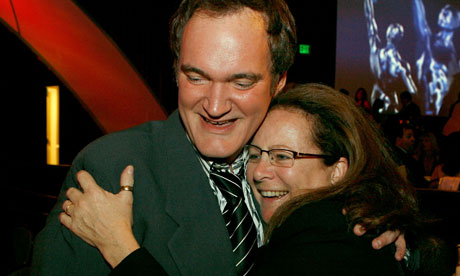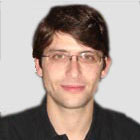Source: http://www.guardian.co.uk/film/filmblog/2010/sep/29/sally-menke-quentin-tarantino-editor
Sally Menke: the quiet heroine of the Quentin Tarantino success story
Tarantino's trusted editor and 'number one collaborator', found dead yesterday, was partly to thank for his signature style
Read Sally Menke's obituary here
Read Sally Menke's obituary here
 A cut above ... Quentin Tarantino with editor Sally Menke in 2007. Photograph: Kevin Winter/Getty Images Sally Menke died this week, aged 56, after going hiking near the Hollywood Hills on a day that was extremely hot even by Los Angeles standards. Her sad death brings to a close the longstanding collaboration with Quentin Tarantino – Menke was the only editor with whom the writer-director has ever worked – that yielded some of the most exhilarating and accomplished films of the past 20 years. He once described her as "hands-down my number one collaborator", noting in an interview for the Grindhouse DVD that "I write by myself but when it comes to the editing, I write with Sally. It's the true epitome, I guess, of a collaboration because I don't remember what was her idea, what was my idea. We're just right there together."
A cut above ... Quentin Tarantino with editor Sally Menke in 2007. Photograph: Kevin Winter/Getty Images Sally Menke died this week, aged 56, after going hiking near the Hollywood Hills on a day that was extremely hot even by Los Angeles standards. Her sad death brings to a close the longstanding collaboration with Quentin Tarantino – Menke was the only editor with whom the writer-director has ever worked – that yielded some of the most exhilarating and accomplished films of the past 20 years. He once described her as "hands-down my number one collaborator", noting in an interview for the Grindhouse DVD that "I write by myself but when it comes to the editing, I write with Sally. It's the true epitome, I guess, of a collaboration because I don't remember what was her idea, what was my idea. We're just right there together."Menke was hiking when the collaboration began, too: she was standing in a phone booth on a remote Canadian mountainside when she learned Tarantino wanted her to cut Reservoir Dogs. Although Tarantino was an untried filmmaker, Menke – whose two previous credits included Teenage Mutant Ninja Turtles – had loved his script, plus the fact that Harvey Keitel was on board, and was attracted by the possibility of working with a director whose interests seemed so ostensibly macho. She thought of Martin Scorsese and Thelma Schoonmaker.
Tarantino later said (in the documentary The Cutting Edge: The Magic of Movie Editing) that he had expected a female editor to be "more nurturing to the movie and to me. They wouldn't be trying to win their way just to win their way, all right? They wouldn't be trying to shove their agenda or win their battles with me. They would be nurturing me through this process." Menke, too, felt this dimension of the working relationship: "I think editors play a big role with directors in giving them support, making them feel like they can look at something that may have trouble or problems and be comfortable enough so that they can approach those problems."
She once described editors to the Observer as "the quiet heroes of movies", noting that "we have a very private relationship with our directors, most often conducted in dark rooms". It could be "so intense", she said in The Cutting Edge, that "I see [Tarantino] more than my husband". He in turn noted in mock-dudgeon that "sometimes I get annoyed with her for not reading my mind 100%. It's not good enough that she reads it 80% of the time."
Many aspects of the style Menke developed with Tarantino were already evident in Reservoir Dogs (1992), from long, dialogue-heavy takes shot with a restless camera to bursts of immersive violence. Another signature was the brilliant use of obscure music over material tellingly heightened through devices such as slow motion. Intriguingly, Menke revealed that "I don't cut to music. I just make the scene work emotionally and dramatically, and then Quentin will come in and lay the track over it and we'll tweak it to the beats." The opening sequence of the film remains a masterclass in the technique.
Their next project, Pulp Fiction (1994), was altogether more ambitious but developed familiar motifs. The scene in which Vincent Vega (John Travolta) and Mia Wallace (Uma Thurman) dance was shot to live playback of Chuck Berry's You Never Can Tell and plays out in sensuous continuous takes rather than the fast cutting that characterises the rest of their date – a sequence that played out almost in real time until Menke helped Tarantino boil it down. "Most editing is painstaking but this was an exciting scene to edit because it had momentum of its own and an obvious magic," she said of the dance scene itself.
Jackie Brown (1997) offered fewer obvious bravura set-pieces but still plays as effortlessly impressive. This clip shows not just a range of judiciously timed reaction shots but also, thanks to the show Chicks Who Love Guns on the TV, a taste of the outrageous and beat-perfect exploitation-genre pastiche that would play an ever-larger role in the Tarantino oeuvre.
This tendency was indulged to the full in Kill Bill: Vols 1 and 2 (2003 & 2004), a riotous two-volume collage of genre tropes for which appropriate editing was absolutely essential. Yet as the fight sequence from Vol 1 in which the Bride (Uma Thurman) faces down the Crazy 88 shows, Menke was adept both at emulating chop-socky style and interpolating other techniques, such as spaghetti-western-style extreme close-ups. As she told the Observer: "The thing with Tarantino is the mix-and-match ... Our style is to mimic, not homage, but it's all about recontextualising the film language to make it fresh within the new genre."
Death Proof – half of the Grindhouse double-bill that Tarantino made with Robert Rodriguez in 2007 – expanded the love of exploitation to the physical material of the film itself, involved distressing the celluloid to mimic ill-treated old prints. "We'd take a pen, a needle or some other implement and scratch the film," Menke told the Editors Guild Magazine, "thrash it against the bushes on the driveway". But the editing was no less important here – in fact, the meat of Death Proof is an extended car chase, a form in which montage is everything. As this clip shows, Menke knew exactly how to ratchet up the tension while maintaining character engagement.
By the time of last year's Inglourious Basterds, Menke reported, the implicit trust between her and Tarantino was such that "he gives me the dailies and I put 'em together and there's little interference". His confidence was amply rewarded. One of the film's most widely praised sequences was the introduction of the charming, sinister SS officer Hans Landa (Christoph Waltz). Thanks to Waltz's performance and Menke's editing, almost unbearable tension was wrung out of the most ostensibly banal subject matter. Menke told the Observer how she had learned from Scorsese and Schoonmaker's example how to "follow the emotional arc of a character through a scene, even if, as in the opening of Inglourious Basterds, they're just pouring a glass of milk or stuffing their pipe. We're very proud of that scene – it might be the best thing we've ever done."
It's worth noting that the nurturing aspect of Menke and Tarantino's relationship went both ways. Editing on Tarantino films would take place not at studio suites but in small, rented private houses – a more personal setup than the norm, but also perhaps a more isolated one. Tarantino thus got into the habit of asking cast and crew members to slip greetings into their work when the opportunity arose, to stop her feeling lonesome.
Every botched take became an opportunity for a goofy "Hi Sally!"
The farewells of the director and his team will surely be no less heartfelt.

No comments:
Post a Comment
Please ensure your posts are appropriate in tone and content! All comments are reviewed by the blog owner before being published.